If you want to strengthen and define your shoulder, you have to include the best exercises in your shoulder workout routine. Shoulder exercises help build strength in your upper body and improve your overall body shape.
To achieve this, you must train with various shoulder exercises that help you develop the anterior deltoid (in front), lateral deltoid (at the side), and posterior deltoid (behind), and you must also work the trapezius muscle in the upper back.
For that, you have to include both compound and isolation shoulder exercises.
- Compound shoulder exercises help recruit multiple muscle groups and contribute to more functional movements. They allow you to lift heavier weights for faster and more consistent progress. These include overhead presses, upright rows and push-ups.
- Isolation shoulder exercises help you focus on the primary muscle group, which means no secondary muscles are taking over. They also allow you to isolate the targeted muscle group effectively. These include front raise, lateral raise, and side raise.
Get ready to push your limits and build the shoulders you deserve.
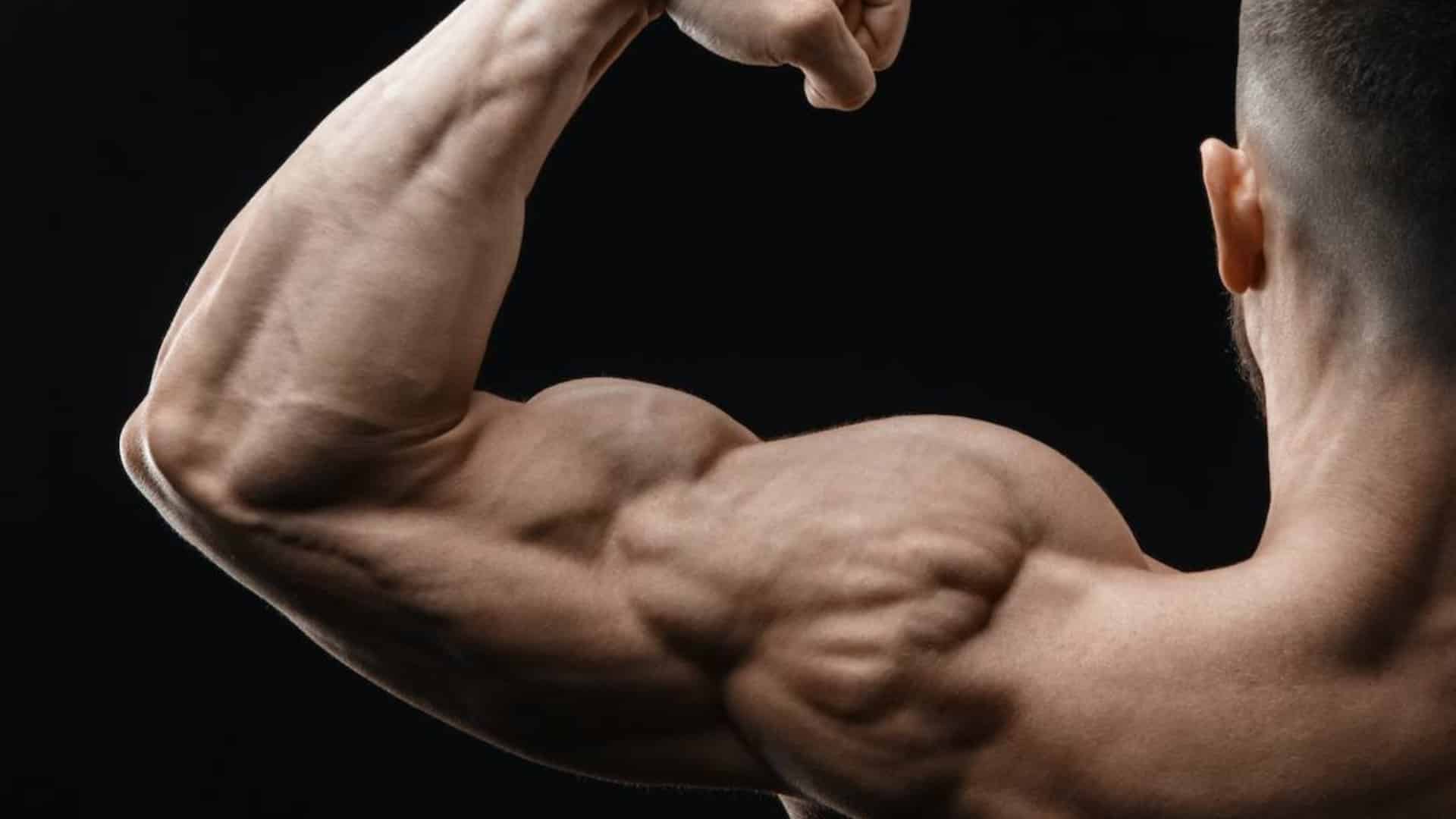
- Shoulders Anatomy And Function
- 10 Best Shoulder Exercises For Mass and Strength
- 1. Overhead Press
- 2. Arnold Shoulder Press
- 3. Smith Machine Behind The Neck Shoulder Press
- 4. Machine Shoulder Press
- 5. Lateral Raise
- 6. Dumbbell Front Raise
- 7. Upright Row
- 8. Rear Delt Fly
- 9. Machine Rear Deltoid Fly
- 10. Face Pull
- Shoulder Workout Routines With Tips and Techniques
- 1. Select Weekly Workouts Sets
- 2. Training Plan As Per Your Goal
- 3. Add Warm-Up Exercises Before Shoulder Workout
- 4. Progressive Overload
- 5. Add Variety in Shoulder Workout
- 6. Rest and Recovery
- 7. Shoulder Workout Routine For Beginner
- 8. Workout Routine For Intermediate
- 9. Shoulder Workout Routine For Advance
- FAQs
- How Many Shoulder Exercises Per Workout
- How Often Should I Train My Shoulder Muscles?
- Takeaways
- References
Shoulders Anatomy And Function
In fitness, “shoulder exercises” refers to resistance exercises that target the deltoid muscle. The shoulder is a “ball-and-socket” joint between the upper arm’s humerus bone and the scapula bone (shoulder blade).
The six main movements at the shoulder are flexion, extension, abduction, adduction, internal rotation, and external rotation.
The deltoid muscle of the shoulder consists of three separate sections or heads.
- The anterior deltoid (In front): It arises from your collar bone and inserts into your humerus (upper arm bone). Your front delt’s main function is to move your arm up, forward, and to your center.
- Lateral deltoid (at the side): Arises from a little area on the shoulder blade called the acromion process and inserts into the humerus. Your lateral delt’s main function is shoulder abduction, bringing it up to the side.
- Posterior deltoid (behind): It arises from the spine of the scapula (upper part of your shoulder blade) and inserts into the humerus. Your rear delts main function is moving the arm outward and backward.
To build an impressive shoulder, you need to work all three of them, along with the trapezius muscle in the upper back.
Trapezius: This large triangular-shaped upper back muscle is often called the trap. Its main functions are to support head movement, stabilize certain arm motions, and provide stability in pushing and pulling movements.

Want to take your gains to the next level? Discover your daily calorie needs with our free TDEE calculator
10 Best Shoulder Exercises For Mass and Strength
The shoulder exercises are divided into pressing, machine, Front raises, Rear Delt fly-type, and push-up pullover exercises.
Here are the 10 best shoulder exercises to help build a massive, well-shaped shoulder muscle.
1. Overhead Press
The shoulder press is the best exercise for building muscle mass and strength. It remains the grand-daddy of all shoulder exercises for building big, round shoulders.
The seated shoulder press is the favorite shoulder exercise among bodybuilders because it builds muscle fast and is a power move.
Performing the exercise while seated upright is a stricter version than standing and prevents cheating the weight upward using momentum generated by the legs.
Note: Dumbbell Pres is also good for training the shoulder muscles. Research has shown that using dumbbells makes your muscles work harder, even if you can’t lift as much weight as compared to the barbell press.
There are several variations of the barbell press for shoulder development.
- Dumbbell shoulder press (single-arm, alternating)
- Standing military press
- Smith machine shoulder press
- Machine shoulder press
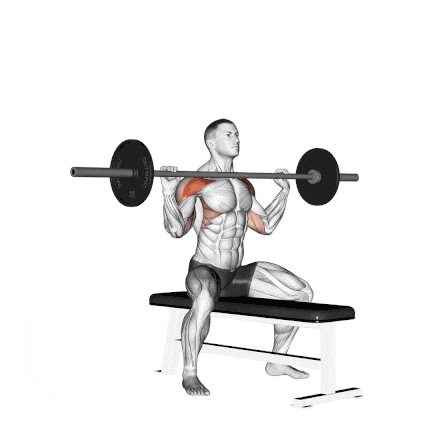
How To Do Seated Barbell Overhead Press
- Place an adjustable bench beneath the bar in an upright position.
- Carefully lift the barbell off the rack or have a spotter hand it to you.
- Hold it at shoulder level, just above your upper chest, with your elbows bent and pointing forward.
- Extend your arms and press the barbell upward. Focus on balancing the barbell and moving in a straight line above your head.
- Hold for 2–3 counts, and then slowly lower the barbell back to the starting position and bring it down to shoulder level.
Tips for Proper Form
- Perform a warm-up with 50% weight for 1-2 sets.
- Keep your head in a neutral position, looking straight ahead, to maintain proper spine alignment.
- Engage your core and avoid excessive arching of your back.
- Exhale as you press the barbell overhead, and inhale as you lower it back down.
Related Post: Barbell Shoulder Exercises To Build Mass And Strength
2. Arnold Shoulder Press
The Arnold press stands out from the crowd when it comes to the best exercise for shoulder muscles with the best range of motion.
It provides a wide range of motion as you lower the dumbbells well down in front, allowing you to achieve the maximum stretch other shoulder exercises lack.
A study found that the Arnold dumbbell press was more effective than the overhead dumbbell press at activating the anterior and medial deltoid muscles.
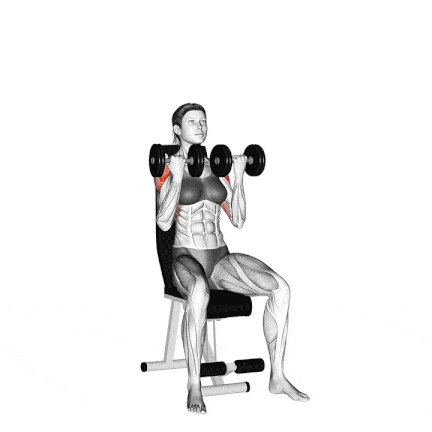
How To Do Arnold Shoulder Press
- Stand straight, holding a dumbbell in each hand.
- Raise the dumbbells to the shoulder position with palms facing you.
- Now press the dumbbells overhead, just like dumbbell presses, twisting them so that the palms face forwards at the top of the movement.
- Now lower the dumbbells in a reverse movement.
- Repeat the desired number of reps.
Tips for Proper Form
- Inhale when you lower the weight and exhale when you lift.
- Keep a controlled motion and avoid jerky movements.
- Keep a strict form. Do not lock your arms overhead.
Know More: Best Dumbbell Shoulder Exercises & Workouts For Mass
3. Smith Machine Behind The Neck Shoulder Press
The standard military press and the overhead dumbbell presses hit more of the anterior head of the deltoid, which is often stimulated a lot, even during the bench press.
Behind the neck press, on the other hand, stimulates all the three heads of the shoulder, It also recruits the triceps, traps, and rhomboids.
The seated behind-the-neck shoulder press with the Smith machine is not recommended, especially for beginners. Bringing the weight behind your neck under a heavy load may damage your shoulder joint.
It is not recommended to perform these Smith machine shoulder exercises if you do not have adequate shoulder mobility.

How To Do Smith Machine Behind The Neck Shoulder Press
- Put a bench under a Smith machine.
- Set the Smith machine bar to the height of your shoulders when you sit on the bench.
- Elevate the bar overhead by fully extending your arms while breathing out.
- Hold the contraction for a second and lower the barbell back to the starting position by inhaling.
- Do 10–12 reps and 3–4 sets with medium light.
Tips for Proper Form
- Don’t bounce the bar off your neck. Perform the exercise in a slow and controlled manner.
- Perform a warm-up with 50% weight for 1–2 sets.
- Keep your elbows flared out, aligning with the shoulders or slightly behind.
Know More: Best Smith Machine Shoulder Exercises And Workout Of All Time
4. Machine Shoulder Press
The shoulder machine press is excellent for building the front and side deltoid muscles.
Machine presses have advantages over free-weight presses, as they provide better stability and safety. They also offer a choice of handgrips. A neutral grip (palms facing together) targets the anterior deltoid better than a pronated grip (palms forward).
This exercise requires strict movement because the bar is fixed to the rack, and the weights can go much lower. This gives the front deltoid muscles a good stretch.
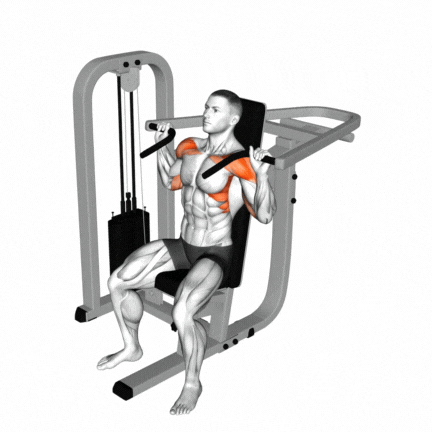
How To Do Machine Press
- Sit with your back against the backrest and your feet flat on the floor.
- Depending on the machine’s design, grip the handles with an overhand or neutral grip (palms facing each other). Make sure your grip is secure and comfortable.
- Bend your elbows at about a 90-degree angle and keep them level with your shoulders.
- Now press the handles overhead until your arms are nearly locked out.
- Lower the handles back to the starting position under controlled motion.
Tips for Proper Form
- Avoid using momentum or excessive swinging of the handle. Keep motion-controlled.
5. Lateral Raise
The side lateral raise with dumbbells works the side of the shoulders, also called the lateral head. It is one of the best shoulder isolation exercises that primarily targets the lateral head of the shoulder.
You might need to use lighter weights with isolation exercises as more load is placed on a specific body part.
As a lighter weight is used, a higher number of reps can be used—anything from 10 to 20.
You can use several lateral raise variations to build a bigger shoulder.
- Cable Lateral Raise
- Incline Lateral Raise
- Machine Lateral Raise
- Single Arm Lateral Raise
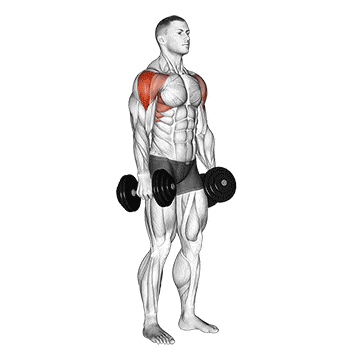
How To Do Dumbbell Lateral Raise
- Stand with your feet shoulder-width apart. Hold dumbbells in each hand with your palms facing inward.
- Keep your elbows slightly bent, and keep your back straight.
- Keep your arms slightly angled forward as you lift them to the sides and away from you.
- Continue raising your arms until they are parallel to the floor or slightly below shoulder level. Avoid lifting them higher than your shoulders to prevent excessive strain on the shoulder joints.
- Pause momentarily at the top, feeling the contraction in your side shoulder muscles (deltoids).
- Slowly lower the dumbbells back down to the starting position in a controlled manner.
Tips for Proper Form
- This exercise is important, and the form is a big part of it.
- Don’t just swing your arms. Keep controlled motion throughout the exercise.
- Perform a warm-up with 50% weight for 1-2 sets.
- You should always use weights that you can handle comfortably.
6. Dumbbell Front Raise
A dumbbell front raise is an excellent exercise for isolating the anterior deltoid muscle and helping to build muscle mass in the front deltoids.
Front dumbbell shoulder raises can be done standing or seated with a pair of dumbbells. They are also done in an alternating movement.
This exercise can work well with a medium to light weight for higher reps.
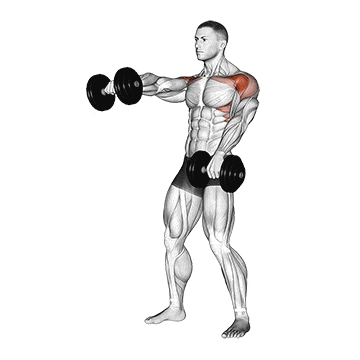
How To Do Alternating Dumbbell Front Raise
- Stand holding a pair of dumbbells across the front of your thighs.
- Your feet are shoulder-width apart, and your knees are slightly bent.
- Raise one dumbbell (say right hand) in front, until it reaches just above shoulder level.
- Now lower the weight (of the right hand) while raising the left in front of you.
- Perform this exercise in this alternating manner.
- Aim for 3 to 4 sets of 12 to 15 reps.
Tips for Proper Form
- Pause momentarily at the top before slowly lowering the dumbbell back to the starting position.
- Keep a controlled motion and avoid jerky movements.
- Avoid arching of the lower back.
- Concentrate on training the front delts, raising dumbbells in front of you, and not raising outside the body.
7. Upright Row
The barbell upright row is a weightlifting exercise that targets the muscles of the shoulder and upper back, including the deltoids, trapezius, as well as the rhomboids, and even the biceps — making it a great addition to any full-body workout.
Barbell upright rows can be done with both narrow grips and wider ones.
- The narrow grip focuses on the trapezius,
- The wider focus is on the entire shoulder girdle.
- Also, the wider grip allows some cheating movement, allowing you to lift more weight.
The upright row variations for shoulder mass and strength.
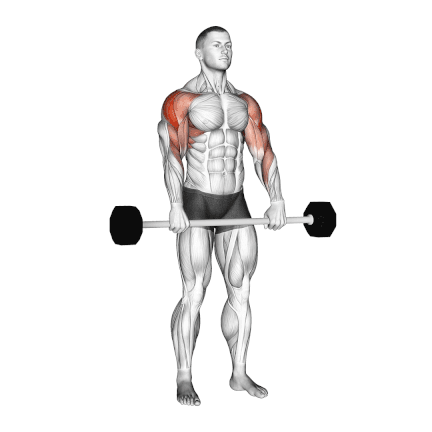
How To Do Barbell Upright Row
- Stand facing the barbell with your feet shoulder-width apart and load it with the weight you want to use.
- To grasp the barbell, hold it with an overhand grip and hands slightly closer than shoulder-width apart.
- Pick up the bar with your back straight and bend your knees.
- Keeping your back straight and eyes facing forward, lift the bar straight up while keeping it as close to your body as possible.
- Hold for a moment before you go back to the starting position.
- Repeat for desired reps.
Tips for Proper Form
- Focus on keeping your elbows higher than your forearms.
- Keep a controlled motion and avoid jerky movements.
- Keep your back straight.
Read More: How To Do Upright Row, The Muscle Worked, Proper Form, Benefits and Its Variations
8. Rear Delt Fly
The dumbbell rear delt fly is a simple yet effective exercise that increases deltoid muscle definition and strength.
The rear delt dumbbell fly targets your upper back muscles and shoulder muscles, particularly the rear deltoids, (backside of your shoulders). It is one of the best to isolate and work specifically on For complete shoulder muscle development.
This exercise can be performed in both standing and seated positions. I prefer the seated version, as it requires strict movement.
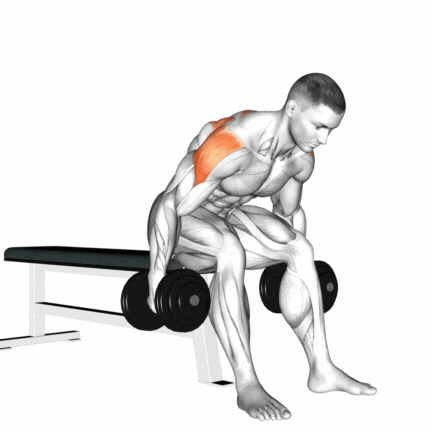
How To Do Dumbbell Rear Delt Fly
- Now lower the dumbbells back to your sides.
- Stand with your feet shoulder-width apart and a slight bend in your knees.
- Hold a dumbbell in each hand with a neutral grip (palms facing each other).
- Bend forward at the hips while keeping your back straight.
- Your torso should be almost parallel to the floor. Maintain a natural arch in your lower back.
- Engage your core and keep your neck in a neutral position. Your gaze should be towards the floor.
- Keep your elbows slightly bent, and raise both arms to the sides until the dumbbells are level with the height of your shoulders.
- Your body should resemble the letter ‘T’ at the top of the movement.
- Hold for a count of two and then slowly lower the dumbbells to the starting position in a controlled manner.
Tips for Proper Form
- Your arms should be parallel to your shoulders.
- Do not lift backward or forward.
- Keep form strict to isolate the rear delts.
9. Machine Rear Deltoid Fly
The machine rear delt fly is an excellent exercise for the rear deltoid. It provides uniform resistance throughout the range of motion and offers several technical grip adjustments. The trajectory and range of motion isolate the posterior deltoid.
How you hold the handles affects the degree of rotation at the shoulder joint.
- Using the horizontal handles with a pronated grip (palms down) is the best method of isolating the posterior deltoid because the shoulder is internally rotated.
- A neutral grip (thumbs up) using the vertical handles allows the lateral deltoid to participate because the shoulder is externally rotated.
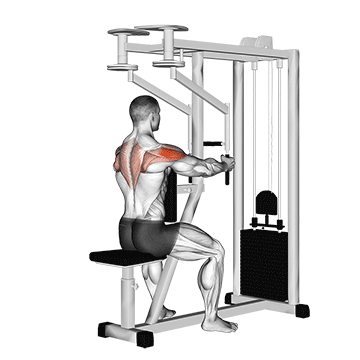
How To Do Machine Rear Deltoid Fly
- Sit facing the rear deltoid machine with your chest against the backrest.
- Grasp the handles directly in front of, arms outstretched at shoulder level.
- Pull the handles back in an arc as far as possible, keeping your elbows high and arms parallel to the floor.
- Return the handles to the start position directly in front.
Tips for Proper Form
- Do not use very heavy weights for this exercise.
- Exhale during effort, and inhale during rest.
- Maintain tension on the rear deltoids.
10. Face Pull
Face pull is a cable machine exercise that primarily targets the rear deltoid and, to a lesser degree, also targets the trap, biceps, and triceps.
Use a cable pulley machine to pull the weight straight toward your forehead.
This exercise prevents muscular imbalance and builds overall shoulder strength.
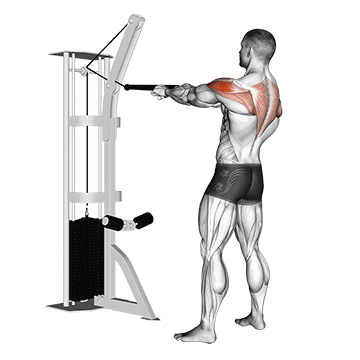
How To Do Face Pull
- Grab the ends of the rope attachment using a neutral grip (palms facing each other) and slightly lean back.
- Pull the rope toward your face as you spread the ends of the rope, so they end up on the sides of your ears just above your shoulders in the finish position.
- Hold this position for as second as you squeeze your shoulder blades together, contracting rear delts and middle traps as hard as possible.
- Then, slowly return the rope to the start position and repeat for reps.
Tips for Proper Form
- Stand straight with feet in a comfortable, balanced stance.
- Be sure to exhale when pulling weight toward your face.
- Think about trying to pinch your shoulder blades as tight as possible when pulling weight toward your face.
- Your upper arms should be straight out to your sides with elbows bent.
Shoulder Workout Routines With Tips and Techniques
1. Select Weekly Workouts Sets
The number of sets you do for shoulder exercises will depend on your fitness goals and current fitness level. Here are some general guidelines:
- Beginners: ~10 sets per week.
- Intermediate: ~15 sets per week.
- Advanced: ~20 sets per week.
When a certain amount of volume stops being effective and your progress stalls, you can add sets to increase volume and use that as a driver of renewed progress.
2. Training Plan As Per Your Goal
- For muscle endurance: Aim for 3–4 sets of 12–15 reps, with moderate resistance.
- For muscle strength: Aim for 3–5 sets of 6–10 reps, with more resistance.
- For muscle hypertrophy (increased muscle size): Aim for 3–4 sets of 8–12 reps, with moderate to heavy resistance.
It is always best to start with fewer reps and sets, then gradually increase as your strength improves.
Furthermore, it is important to allow for adequate rest between sets, typically 60–90 seconds.
3. Add Warm-Up Exercises Before Shoulder Workout
Warm-up is the process of preparing your body for physical activity or exercise. It involves performing low-intensity exercises that gradually increase your heart rate, blood flow, and body temperature to strengthen your body’s readiness for the workout.
You should perform a warm-up for at least 5–10 minutes before any shoulder workout to prepare your body for the activity ahead.
The type of warm-up exercise you choose should be tailored to the specific workout you will be performing.
Here are some of the best warm-up exercises for a shoulder:
- Jumping jacks
- Arm circles
- Push-ups
- Chest flies with light weights
- Dynamic stretches
4. Progressive Overload
Once you can comfortably perform your sets and reps, bump the weight by a small amount (5-10%) for continued progress.
Explore techniques like drop sets (reducing weight mid-set for more reps) or supersets (performing two exercises back-to-back) to challenge your muscles further.
5. Add Variety in Shoulder Workout
When you add exercises that train all three heads of delt, you effectively train your shoulder to build bigger and stronger. Like to train:
- Anterior Deltoid: Front raises, overhead presses.
- Lateral Deltoid: Lateral raises, upright rows.
- Posterior Deltoid: Reverse flyes, bent-over lateral raises.
6. Rest and Recovery
Like any other muscle group, your shoulders need time to repair and rebuild after a tough workout.
- Allow at least 48 hours of recovery between intense shoulder workouts.
- Incorporate stretching and mobility exercises to maintain flexibility.
- Use techniques like foam rolling and massage to reduce muscle soreness.
7. Shoulder Workout Routine For Beginner
This workout contains multiple shoulder exercises designed to target all the muscles in your shoulder and increase overall muscle mass.
| Exercise | Sets | Reps |
|---|---|---|
| Dumbbell Shoulder Press | 3-4 | 8-10 |
| Dumbbell Lateral Raise | 3-4 | 8 |
| Bent Over Raise | 4 | 8-10 |
8. Workout Routine For Intermediate
| Exercise | Sets | Reps |
|---|---|---|
| Arnold Shoulder Press | 4 | 8-10 |
| Smith Machine Press | 3-4 | 10-12 |
| Dumbbell one-arm lateral raise | 4 | 10-12 |
| Dumbbell Upright Row | 3 | 8-10 |
9. Shoulder Workout Routine For Advance
| Exercise | Sets | Reps |
|---|---|---|
| Barbell Shoulder Press | 4 | 8-12 |
| Dumbbell Front Raise | 3-4 | 10-12 |
| Bent Over Lateral Raise | 4 | 8-10 |
| Barbell Upright Row | 3 | 10-12 |
| Face pull | 3 | 8-10 |
FAQs
How Many Shoulder Exercises Per Workout
- Beginners should do 2–3 exercises per week. (~10 sets)
- Intermediate should do 3–4 exercises per week. (~15 sets)
- Advanced should do 5–6 exercises per week. (~20 sets)
How Often Should I Train My Shoulder Muscles?
You should train your shoulder muscles 1–2 times per week, with at least 48 hours of rest between workouts. This allows for proper muscle recovery and growth.
Takeaways
Tons of shoulder exercises will allow you to constantly progress and hit your shoulder from different angles.
The key to achieving hypertrophy (building muscle) with exercises is maximizing tension and time under tension.
Thanks for reading; enjoy your Workout.
References
- Schoenfeld, B. J., Ogborn, D., & Krieger, J. W. (2017). Dose-response relationship between weekly resistance training volume and increases in muscle mass: A systematic review and meta-analysis. Journal of sports sciences, 35(11), 1073–1082.
- The Effect of Weekly Set Volume on Strength Gain: A Meta-Analysis.
- Hrysomallis C. Effectiveness of strengthening and stretching exercises for the postural correction of abducted scapulae: a review. The Journal of Strength and Conditioning Research. 2010;24(2):567-574.
- Overhead shoulder press – In-front of the head or behind the head? Journal of Sport and Health Science. Volume 4, Issue 3, September 2015, Pages 250-257.

Manish is a NASM-certified fitness and nutrition coach with over 10 years of experience in weight lifting and fat loss fitness coaching. He specializes in gym-based training and has a lot of knowledge about exercise, lifting technique, biomechanics, and more.
Through “Fit Life Regime,” he generously shares the insights he’s gained over a decade in the field. His goal is to equip others with the knowledge to start their own fitness journey.
